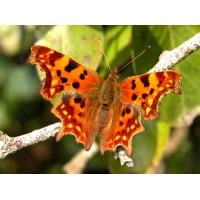SPRING and SUMMER PUPAE You can order these NOW in advance
Large White Butterfly Pieris brassicae
No longer the common butterfly it once was. Summer pupae may hibernate, especially if chilled, and some will emerge to give a further generation.
Winter pupae are stored cool and normally hatch in May, though some occasionally develop during winter.
This is a good species for the inexperienced, and as an introduction to rearing larvae.
The larvae feed on cabbage but also most Cruciferae which can be better and less smelly for captive rearing! Horseradish is ideal for its large leaves and other species include Rape, Mustard, Sweet Rocket, Turnip and Watercress.
There are two or more generations in a year.
European Swallowtail Papilio machaon gorganus
Summer Swallowtail pupae produce adults in 2-4 weeks. A large and truly magnificent butterfly, as big as any in Europe.
Lay in the emerging cage on a base such as coir or greengrocer's imitation grass, that helps to maintain moisture.
The adults need nectar flowers and growing tender fronds of foodplant. In summer they also lay on the umbelliferous flowers of the foodplant.
The larvae are very easy to rear on Fennel, Carrot leaves and Parsnip leaves and flowers (wild and cultivated). One of the most attractive butterfly larvae and a joy to rear!
Eastern Festoon Allancastria cerisyi
Found in Eastern Europe into Asia Minor. This group finds itself between the Apollos and Swallowtails. The larvae feed on local Aristolochia species and will normally take Birthwort A. clematitis.
Becoming harder to obtain, these pupae overwinter in a cold place and will emerge usually in May when brought out to emerge.
Marsh Fritillary Eurydryas aurinia
The butterflies fly from May into June. Eggs are laid in large clusters on the underside of Devil’s Bit Scabious.The larvae Feed on Honeysuckle (wild is best), Teasel Snowberry or the natural foodplant Devil’s Bit Scabious. The larvae live in a tightly formed web, growing only a little before they hibernate in autumn.
Marsh Fritillary Eurydryas aurinia
The butterflies fly from May into June. Eggs are laid in large clusters on the underside of Devil’s Bit Scabious.The larvae Feed on Honeysuckle (wild is best), Snowberry or the natural foodplant Devil’s Bit Scabious. The larvae live in a tightly formed web, growing only a little before they hibernate in autumn.
New Clouded Yellow Colias australis
Because of travel prohibition our normal breeders will not have stock this year. We are therefore hoping to source pupae from Europe. If it proves impossible, orders will be booked for supply in the summer of 2021.
Almost indistinguishable from the Pale Clouded Yellow hyale. This species was not recognised until 1947 when a Belgian entomologist, M. Berger, found that the larvae not only fed on Horseshoe Vetch Hippocrepis, but are totally different in appearance, having a brilliantly coloured pattern in black, yellow and green. Larvae will produce butterflies again this season. They will also feed on Crown Vetch Coronilla.
Brimstone Gonepteryx rhamni
The pupa is a remarkable and lovely shape. The butterflies hatch easily. Difficult to hibernate, but you can keep them for a while with fresh nectar flowers, and then release to hibernate and hopefully breed in your area.
Resulting pupae produce butterflies this summer. They hibernate amongst ivy (when closed, the wings resemble ivy leaf undersides). Because they are difficult to hibernate in captivity release the butterflies in summer sunshine, you may help to perpetuate the species to re-appear as one of the earliest and most prominent butterflies to be seen each spring in your area.
Clouded Yellow Butterfly Colias crocea
These pupae produce butterflies in a week or two at 18-20 degrees.
A great favourite with entomologists and extremely easy to rear on potted Clover. The larvae grow fast and will produce butterflies very quickly, particularly in warm conditions.
Bath White Pontia daplidice
The larvae feed on Mignonette, a flower of chalk soil, but they also feed on various Mustard family Cruciferae, and can be reared on the heads of Cauliflower. This is a very rare migrant to
Small Tortoiseshell Aglais urticae
Suddenly this species has become scarce, in a very short time, though last season showed some recovery, there are very few to be seen this summer. The butterflies emerge in a little over two weeks, dependent on temperature.
The butterflies can be kept in a cage for a few days, with plenty of flowers for nectar, and then released to help the wild populations.
Comma Butterfly Polygonia c-album
A chance to breed this attractive British butterfly, or to reinforce local populations by releasing the adultd. Fascinating larvae with curious half and half markings in black, brown and white, mimicking a bird dropping. The larvae feed on Stinging Nettle, Elm and Hop. They live singly. Fast growing.
Beckeri Marsh Fritillary Euodrydryas beckeri Now considered as a species separate from aurinia.
This is the most magnificent form of the Marsh Fritillary – very large, boldly marked and the brightest colouring and pattern of all. Beckeri occurs in parts of Spain, Portugal and North Africa. This stock is from Portugal. The larvae feed on Honeysuckle. In the wild these hibernate. It may be possible to keep summer larvae warm and with longer day length to get them to develop and produce butterflies again the same year. This has not yet been tried.












